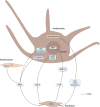Emerging Roles of Dermal Fibroblasts in Hyperpigmentation and Hypopigmentation: A Review
- PMID: 39780507
- PMCID: PMC11711935
- DOI: 10.1111/jocd.16790
Emerging Roles of Dermal Fibroblasts in Hyperpigmentation and Hypopigmentation: A Review
Abstract
Background: Skin pigmentation disorders may increase patients' psychological burdens. Consequently, they are increasingly attracting attention. Dermal fibroblasts have been shown to regulate pigmentation by secreting soluble factors.
Aim: This study aimed to summarize recent findings on the effects of dermal fibroblasts on hyperpigmentation and hypopigmentation, enabling the discovery of new therapeutic targets.
Methods: PubMed was searched for literature on fibroblast factors, hyperpigmentation, and hypopigmentation, and a comprehensive summary and analysis were performed.
Results: Fibroblasts secrete both cytokines that promote pigmentation, including stem cell factor (SCF) and keratinocyte growth factor (KGF), and small amounts of those that inhibit pigmentation, such as Dickkopf1 (DKK1) and transforming growth factor (TGF)-β. Fibroblast-derived extracellular matrix (ECM) can also affect melanocyte tyrosinase activity and the transfer of melanosomes. In hyperpigmentation disorders, such as melasma and solar lentigines, the secretion of pigmentation-promoting factors increases, and the activity of key enzymes in melanin production is elevated. In hypopigmentation disorders, including vitiligo, the secretion of melanogenic factors decreases while the factors that inhibit pigmentation increase. Fibroblasts may serve as a new therapeutic target, providing new insights to precisely treat pigmentary disorders.
Conclusions: Fibroblasts synthesize and secrete various cytokines and proteins that modify melanin synthesis and transfer through different signaling pathways, playing prominent roles in pigmentary skin disorders, such as photoaging, melasma, solar lentigo, and vitiligo.
Keywords: cytokine; fibroblasts; melanocytes; pigmentation.
© 2025 The Author(s). Journal of Cosmetic Dermatology published by Wiley Periodicals LLC.
Conflict of interest statement
The authors declare no conflicts of interest.
Figures


Similar articles
-
Precise role of dermal fibroblasts on melanocyte pigmentation.J Dermatol Sci. 2017 Nov;88(2):159-166. doi: 10.1016/j.jdermsci.2017.06.018. Epub 2017 Jul 1. J Dermatol Sci. 2017. PMID: 28711237 Review.
-
Emerging role of dermal compartment in skin pigmentation: comprehensive review.J Eur Acad Dermatol Venereol. 2020 Dec;34(12):2757-2765. doi: 10.1111/jdv.16404. Epub 2020 May 13. J Eur Acad Dermatol Venereol. 2020. PMID: 32243635 Review.
-
The role of reflectance confocal microscopy in the diagnosis and management of pigmentary disorders: A review.J Cosmet Dermatol. 2023 Dec;22(12):3213-3222. doi: 10.1111/jocd.15827. Epub 2023 Sep 27. J Cosmet Dermatol. 2023. PMID: 37759421 Review.
-
Mechanisms underlying post-inflammatory hyperpigmentation: lessons from solar lentigo.Ann Dermatol Venereol. 2012 Dec;139 Suppl 4:S148-52. doi: 10.1016/S0151-9638(12)70127-8. Ann Dermatol Venereol. 2012. PMID: 23522630 Review.
-
A20 ameliorates advanced glycation end products-induced melanogenesis by inhibiting NLRP3 inflammasome activation in human dermal fibroblasts.J Dermatol Sci. 2023 Nov;112(2):71-82. doi: 10.1016/j.jdermsci.2023.09.002. Epub 2023 Sep 7. J Dermatol Sci. 2023. PMID: 37741724
Cited by
-
Cutaneous Changes Beyond Psoriasis: The Impact of Biologic Therapies on Angiomas and Solar Lentigines.Medicina (Kaunas). 2025 Mar 22;61(4):565. doi: 10.3390/medicina61040565. Medicina (Kaunas). 2025. PMID: 40282856 Free PMC article.
References
-
- Wu Y., Yang Y., Lin Y., et al., “Emerging Role of Fibroblasts in Vitiligo: A Formerly Underestimated Rising Star,” Journal of Investigative Dermatology 144, no. 8 (2024): 1696–1706. - PubMed
-
- Sarkar R., Bansal A., and Ailawadi P., “Future Therapies in Melasma: What Lies Ahead?,” Indian Journal of Dermatology, Venereology and Leprology 86, no. 1 (2020): 8–17. - PubMed
-
- Mohd Nor N. H., Berahim Z., Azlina A., Mokhtar K. I., and Kannan T. P., “Identification and Characterization of Intraoral and Dermal Fibroblasts Revisited,” Current Stem Cell Research & Therapy 12, no. 8 (2017): 675–681. - PubMed
-
- Bellei B. and Picardo M., “Premature Cell Senescence in Human Skin: Dual Face in Chronic Acquired Pigmentary Disorders,” Ageing Research Reviews 57 (2020): 100981. - PubMed
Publication types
MeSH terms
Substances
LinkOut - more resources
Full Text Sources

